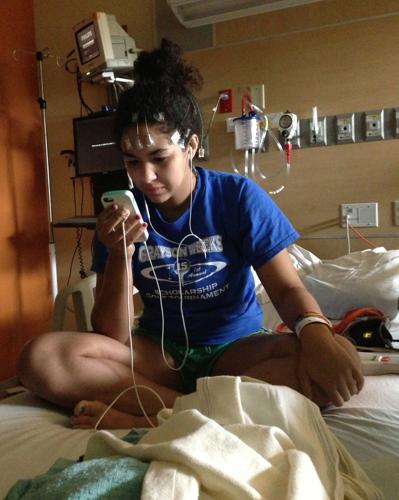In February 2012, 15-year-old Kelsey Keefe was at church with her family and began to feel sick, her heart racing beneath her chest. Just minutes later, she fainted into her mother’s arms.
After months of testing and hospital stays, Keefe was diagnosed with a syndrome that would change almost every aspect of her life.
POTS, or postural orthostatic tachycardia syndrome, is a lesser-known condition that affects the nervous system and causes poor blood circulation. It impacts more than 1 million people worldwide and is most common in women between the ages of 15 and 50.
“It impairs the nervous system, which controls all of the automatic functions of our body, so things like breathing, digestion, heart rate, blood pressure, temperature control, all of those kinds of things,” said Emily Rich, an occupational therapist at Tucson Medical Center. “When people with POTS stand up too quickly or are standing for a long period of time, they feel lightheaded, their heart starts to beat fast, they have chest pain, cognitive symptoms, shortness of breath, headaches.”
When most people stand, their heart rate increases by 10 to 15 beats per minute and then returns to normal. In patients with POTS, heart rates will increase by 40 beats per minute in kids and 30 beats per minute in adults.
“When you stand up, your veins should contract. So, when you stand, and gravity takes over, blood rushes to your legs and we need some mechanism to get that blood back to the heart and circulating again,” said Dr. Brian Blair, a pediatric cardiologist in Tucson who was also one of Keefe’s doctors. “If you don’t have good constriction of your veins, then the blood just kind of pools down there and is not getting back to the heart quickly enough. The hearts response to that emptiness is to speed up.
“We think that’s what’s happening in these POTS patients and they could get a variety of symptoms associated with that.”
In many patients with POTS, the symptoms don’t just occur when they stand. It can also happen when they are sitting for too long because blood isn’t properly flowing. This was the case for Keefe.
While the exact cause of POTS is unknown, there are some theories about how people develop the syndrome. According to Rich, some people develop a sudden onset of symptoms following a viral illness, a surgery or a concussion. Other people have symptoms that happen slowly over time, and that’s usually associated with conditions such as migraines, chronic fatigue or chronic pain.
With no clear cause, POTS is particularly difficult to diagnose. In the United States alone, it takes an average of four years to diagnose, according to Rich.
“This condition is not rare, but it’s really poorly recognized,” said Rich, who is the only occupational therapist in Arizona who treats patients with POTS. “We’re actually doing a much better job compared to the rest of the country because we have several doctors within the community who are aware of it. But at the same time, the recognition still isn’t where it should be. The diagnostic delay is still too long and, with that, there’s not enough providers.”
Keefe, now 23, was in and out of the hospital for fainting, which was also causing seizures, and no one could give her any answers. After being admitted to TMC for a week and undergoing many tests, the doctors told her to keep her blood pressure under control.
Almost immediately after that hospital stay, Keefe fainted again, breaking her wrist and dislocating her knee. She went back to the hospital and was admitted for two months.
Keefe couldn’t do anything by herself, including go to the bathroom or take a shower. At this point, she was fainting sometimes multiple times a day.
“I had one nurse come in and tell me I was ruining my mom’s life, that I was faking it and I just didn’t want to go to school and just needed to get over it,” she said. “It got to the point where I actually thought I was faking it.”
According to Rich, this is not uncommon among POTS patients.
“It’s a population who is constantly told ‘it’s all in your head,’” she said. “For years and years, they have been told it’s anxiety, psychiatric illness, there’s nothing wrong and they’re constantly having to teach people what it is.”
Finally, in the last week of Keefe’s hospital stay, Blair conducted a tilt table test to help evaluate the cause of the unexplained fainting.
Keefe was strapped to an adjustable table that was moved to multiple positions. Her heart rate and blood pressure were monitored in each position to evaluate her body’s cardiovascular response to the change in position. Once the table was adjusted to 60 degrees, she fainted and had a seizure. At this point, she was diagnosed with POTS.
“I think I started crying,” she said. “I was like, ‘We finally know what it is.’”
Even after her diagnosis, Keefe’s journey was far from over. After being released from TMC, she was transferred to a rehab facility so that she could learn how to cope with her symptoms. She was placed on beta blockers to stabilize her blood pressure, had to change her diet and went through extensive physical therapy.
Lifestyle changes
Keefe was an active teenager. As a sophomore at Santa Rita High School at the time, she was a member of student council, the thespian club and the volleyball team. She said she went from being an athlete to having to sit in a wheelchair for several months following her hospital stay.
“I had to change the way I do everything,” she said. “When I wake up in the morning, if I’m late, I can’t just jump out of bed and jump in a hot shower and get ready. I just have to be aware all the time.”
When she did go back to school, she was determined to be able to play volleyball again, but she had to wear a helmet to protect her just in case she fainted. A company called Gamebreaker heard Keefe’s story and sent her a pink, custom helmet with her name on it.
While she did return to school and play volleyball the following season, Keefe said her symptoms were sometimes so debilitating that it prevented her from finishing school on time. She was supposed to graduate high school in 2014 but didn’t finish until 2018.
Keefe’s condition impacted her family and friends as well. Her mom, Colleen Keefe, had to teach all of her friends what to do if Kelsey fainted.
“Things that all of her friends were doing, she couldn’t do,” Colleen Keefe said. “Like they were going boating out on the lake, and she’d be sitting for a long time and out in the heat, two things that could cause syncopal events or seizures.”
Although she couldn’t do as many activities as she could before, Kelsey Keefe said her family and friends adjusted to the changes and stuck by her side.
For Colleen Keefe, being an advocate for Kelsey’s health became a full-time job. Because POTS isn’t very well known, even in the medical community, Colleen Keefe had to educate people about it to ensure her daughter received the proper care.
“It was so hard to see what she had to go through, all of the pain and discomfort, and not know what her life was going to look like,” Colleen Keefe said.
Since her diagnosis, Kelsey Keefe has seen many doctors and tried different things to manage her symptoms. In 2013, a loop recorder was implanted into her chest to monitor her heart and record what was happening when she fainted and had seizures.
Because there aren’t a lot of treatments available, Kelsey Keefe said she’s also had to find a way to manage a lot of symptoms on her own.
“She was taught a lot of these signs in the hospital and they said, ‘When you feel these things, you need to get to the ground,’” Colleen Keefe said.
“So, when she finally came out of the hospital, we’d be walking in Target and sometimes she would just sit down right in the middle of the aisle.”
Now, as an adult, Kelsey Keefe said her symptoms aren’t as bad, but she still faints once every couple of months. She said she now recognizes the symptoms and knows how to handle them better.
“I’ll still have really bad symptoms some days, we call them POTS days,” she said. “I’ll just feel really weak and tired and sick to my stomach, to the point that I can’t even get out of bed sometimes.”
After fainting by herself inside a store, Kelsey Keefe said she’s also had to make sure she’s with someone who knows how to handle it.
“It’s like the most terrifying, because no one knows what to do,” she said. “When I’m having bad days, if I can help it, I won’t go out. But if I need to go out, I’ll have someone with me or have someone drive me. ”
Kelsey Keefe is in her third semester at Pima Community College studying criminal justice and is working as a waitress.
Although her symptoms have become easier to manage, she said she hopes more physicians will continue to learn about POTS and work to find better treatments and eventually a cure.





